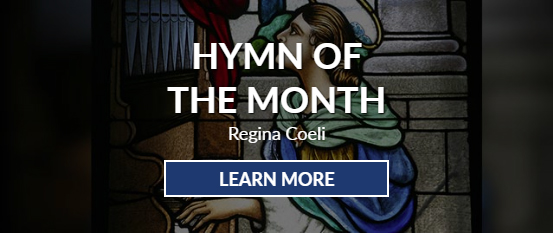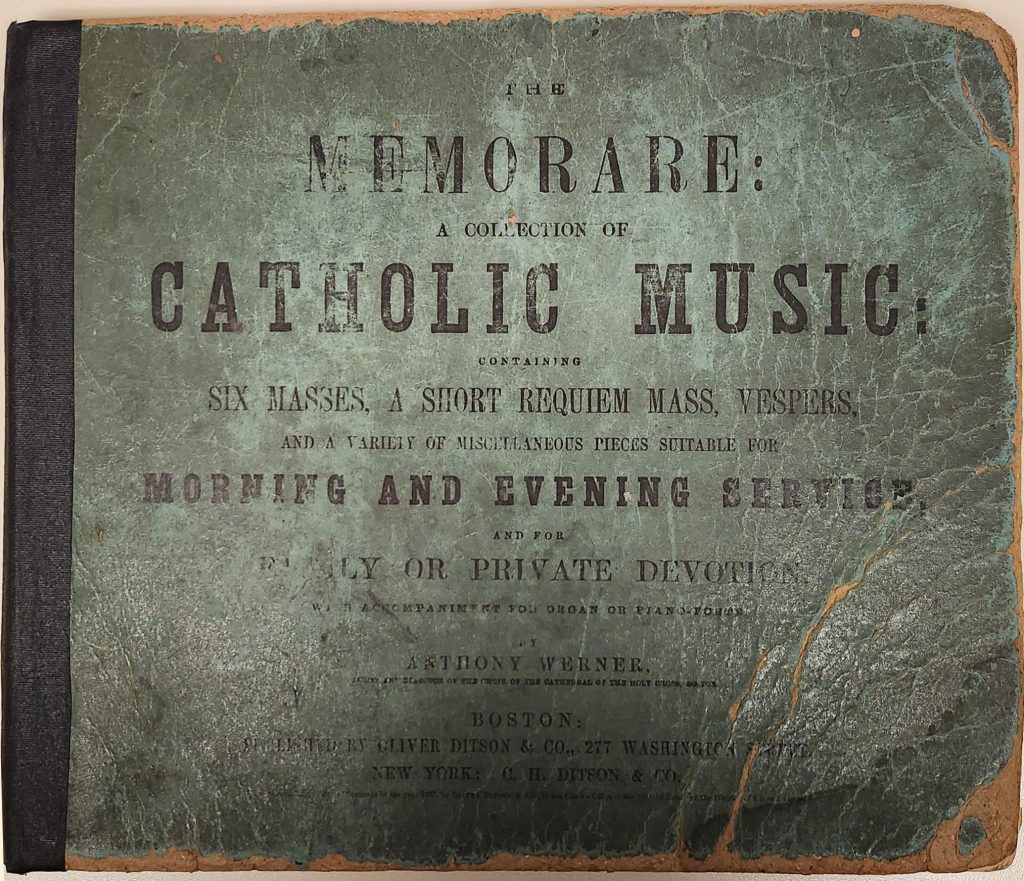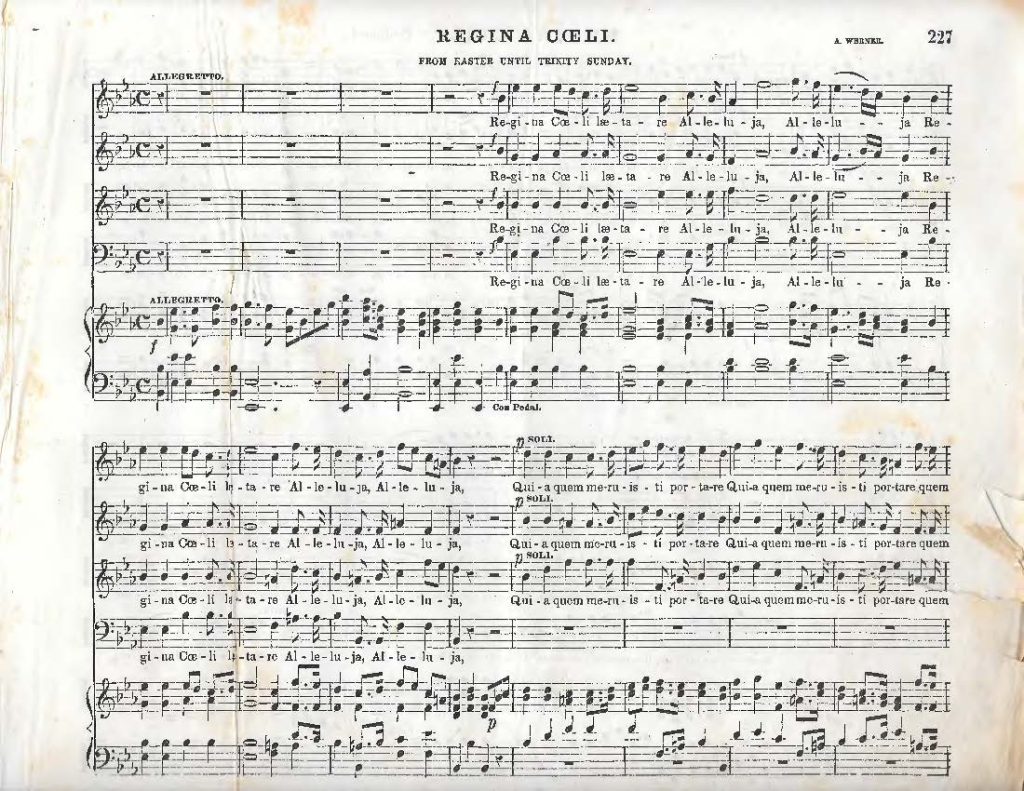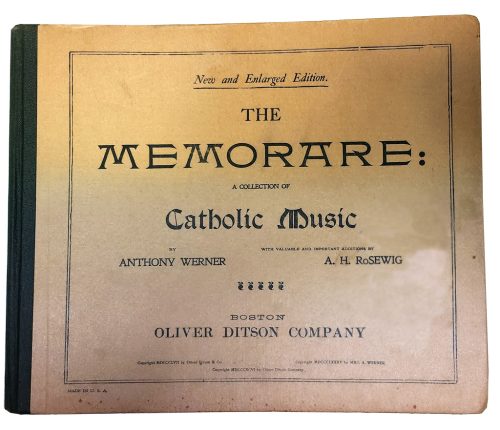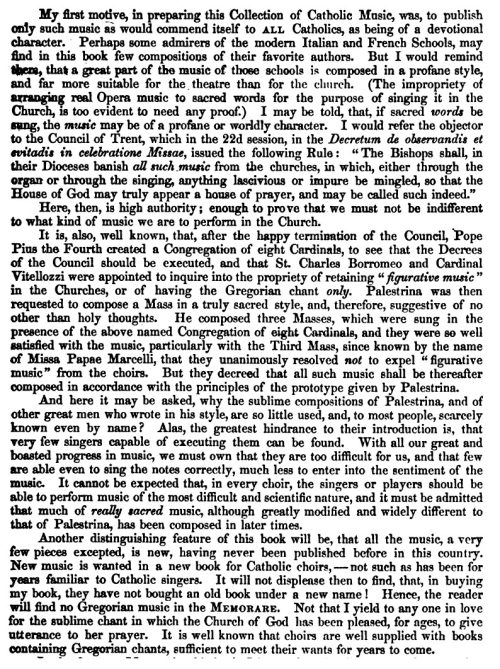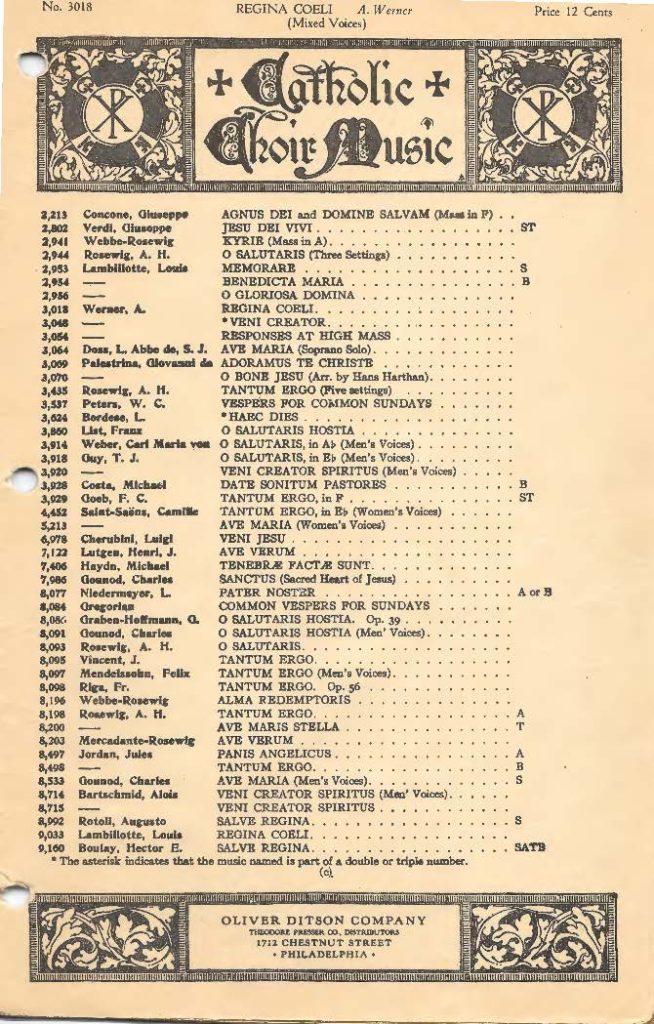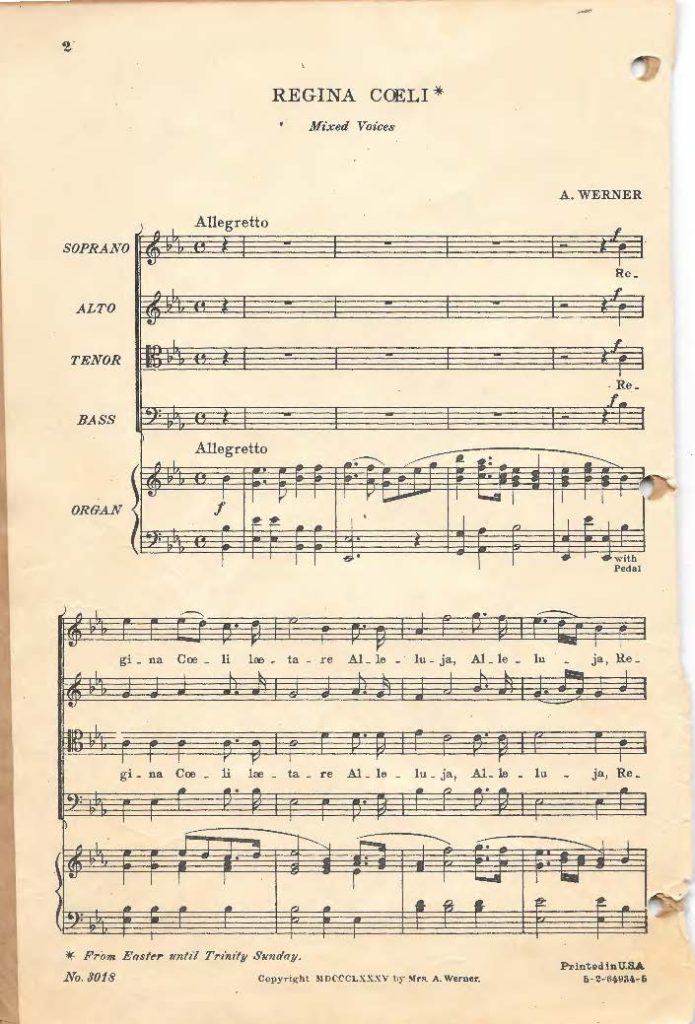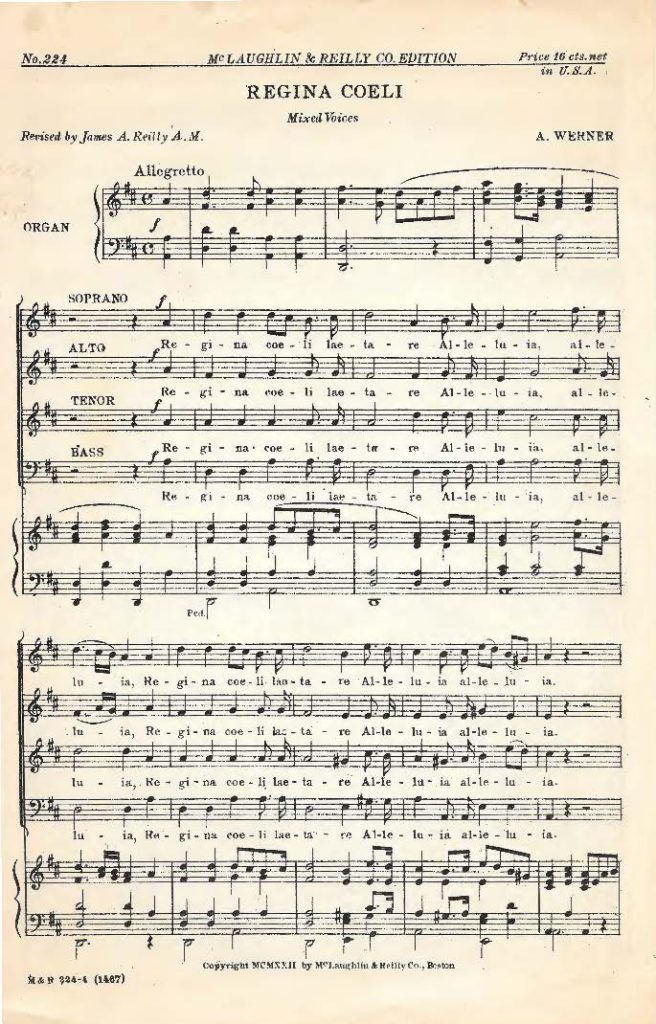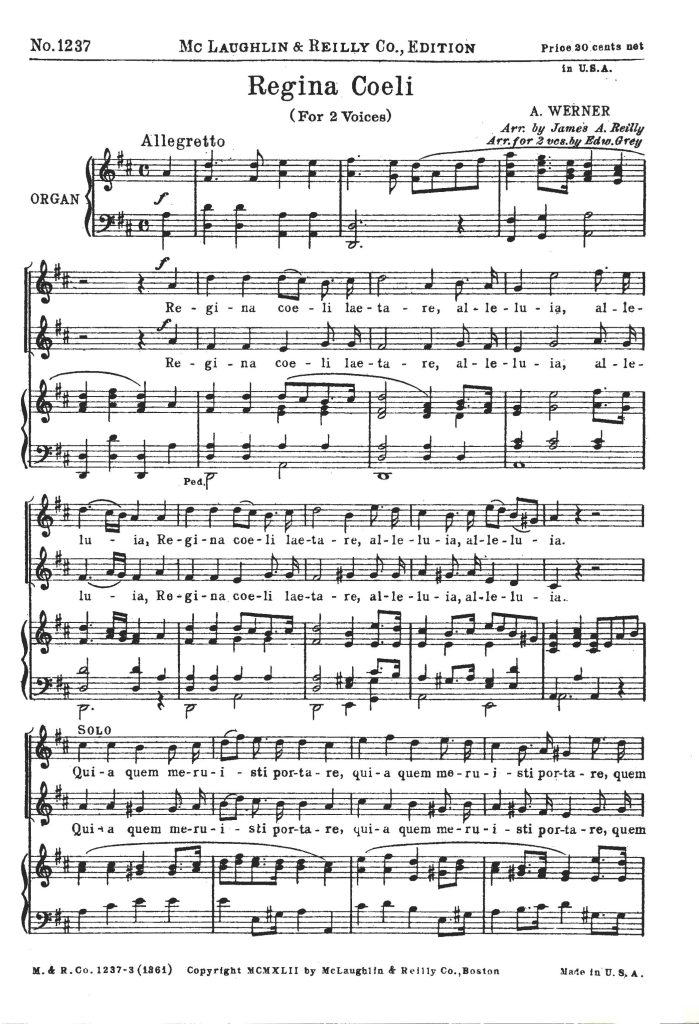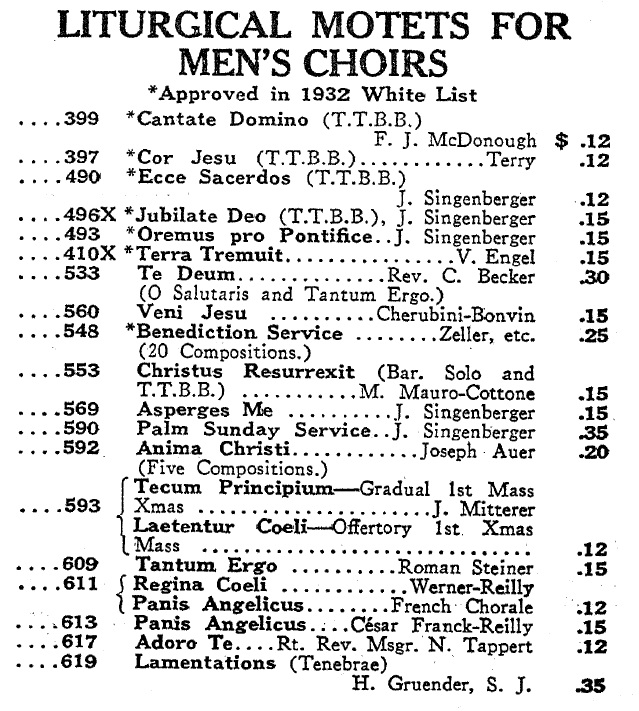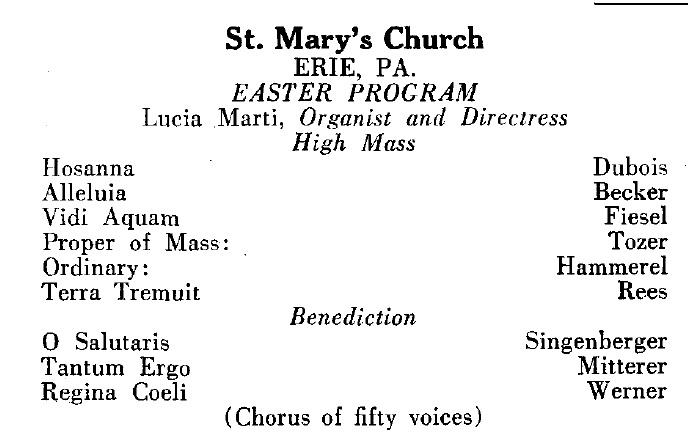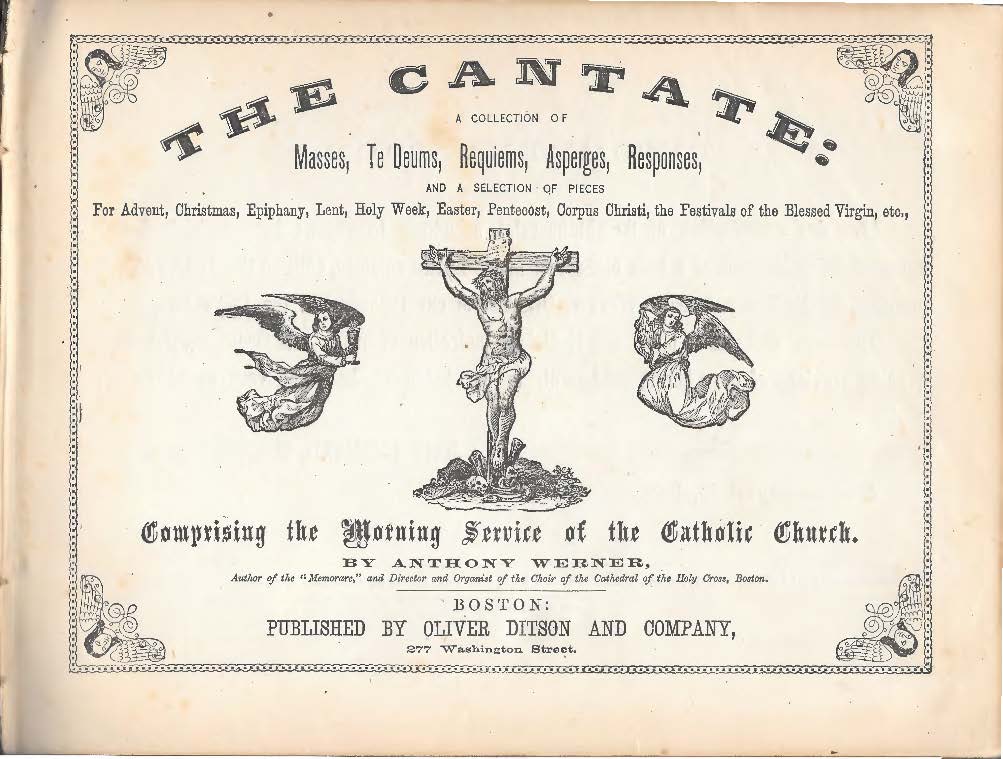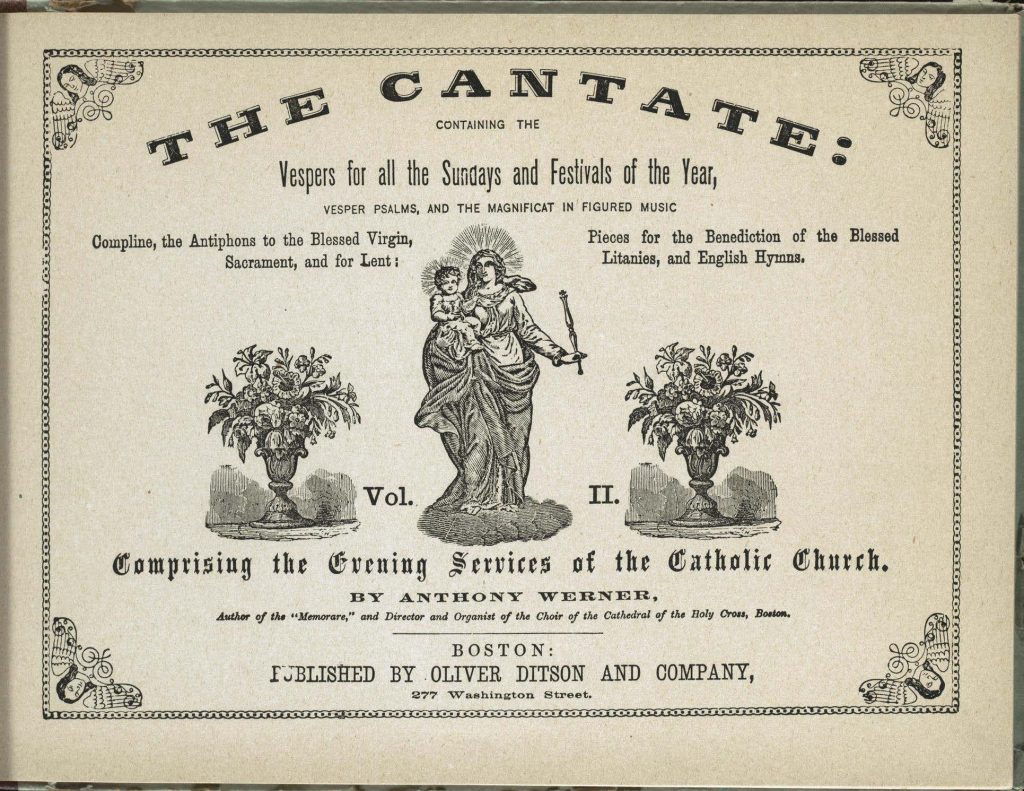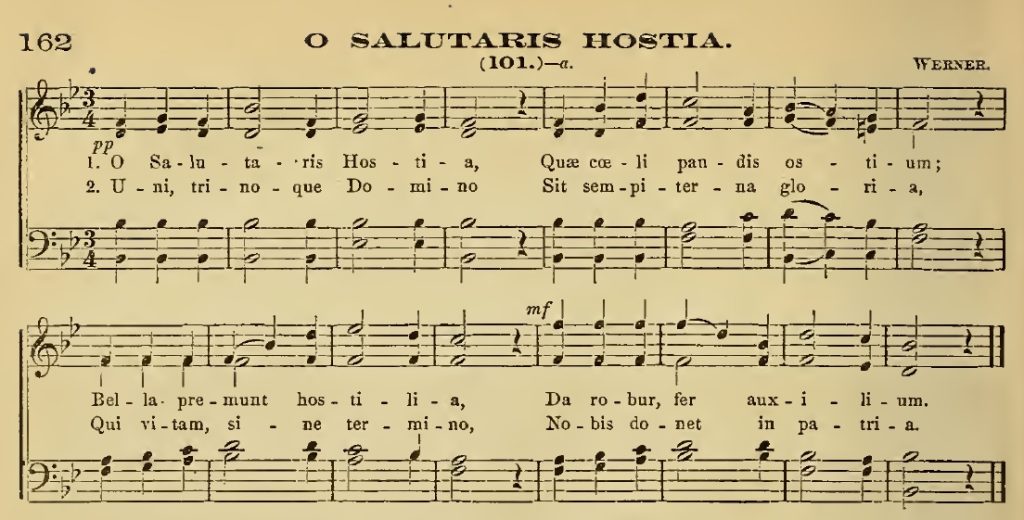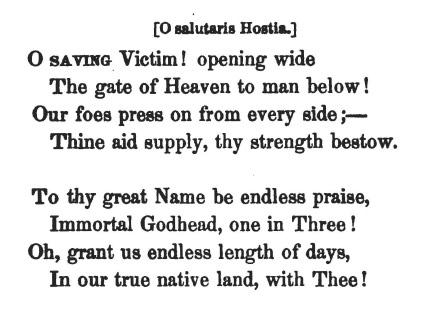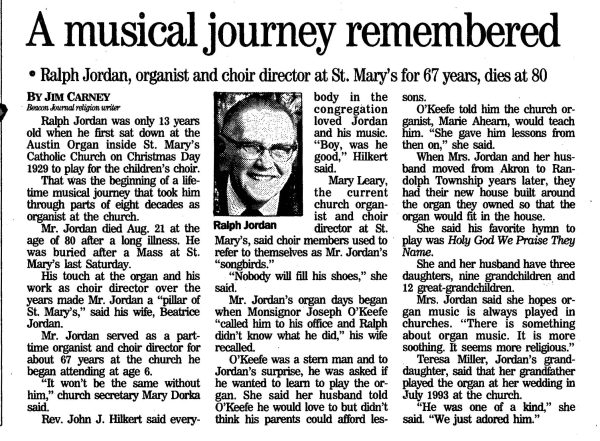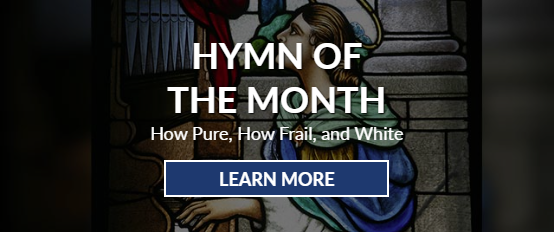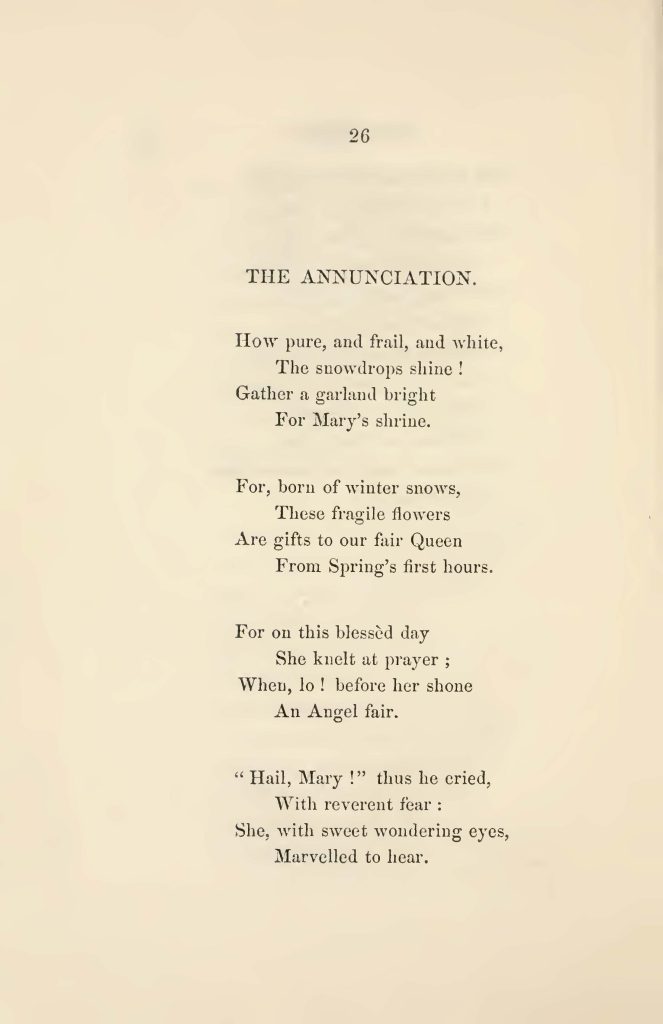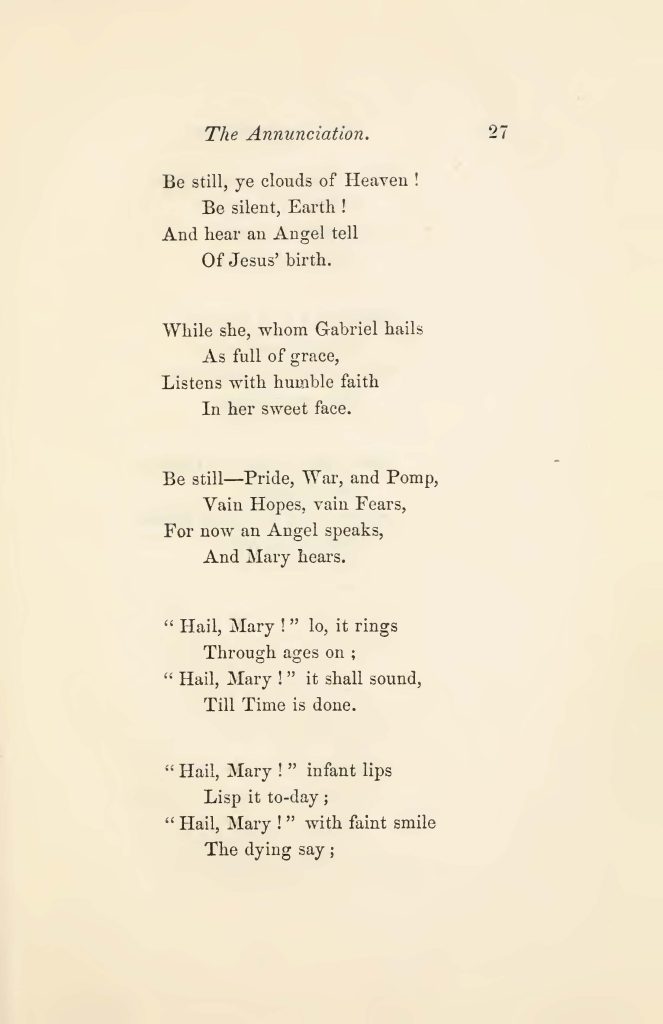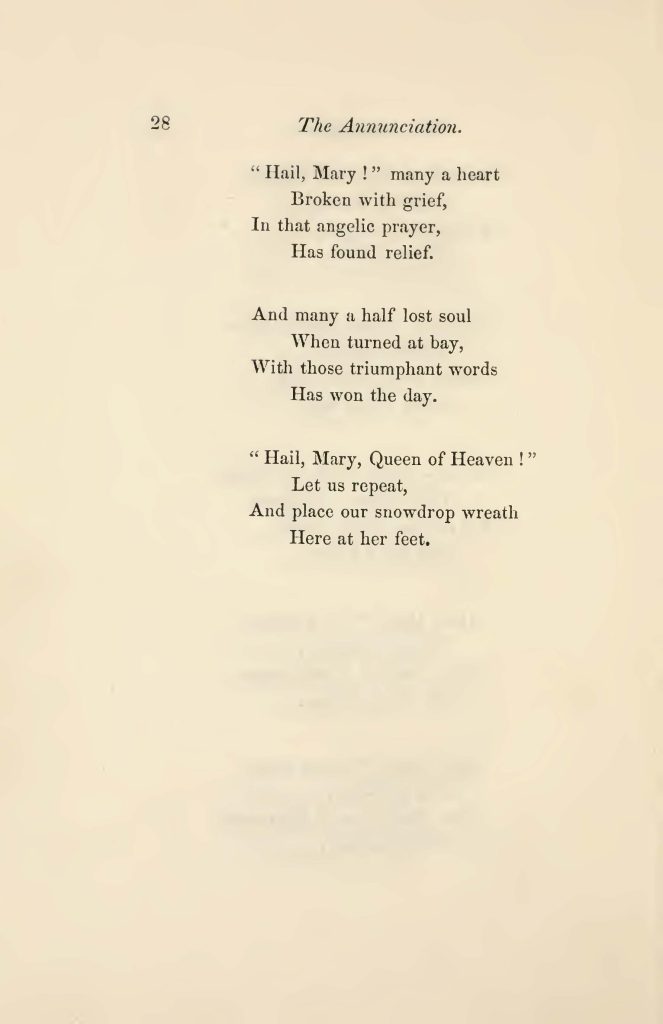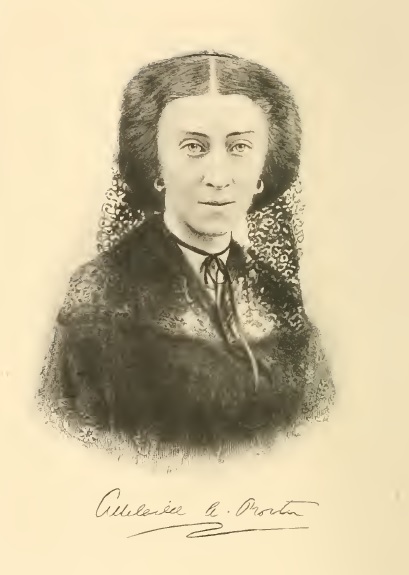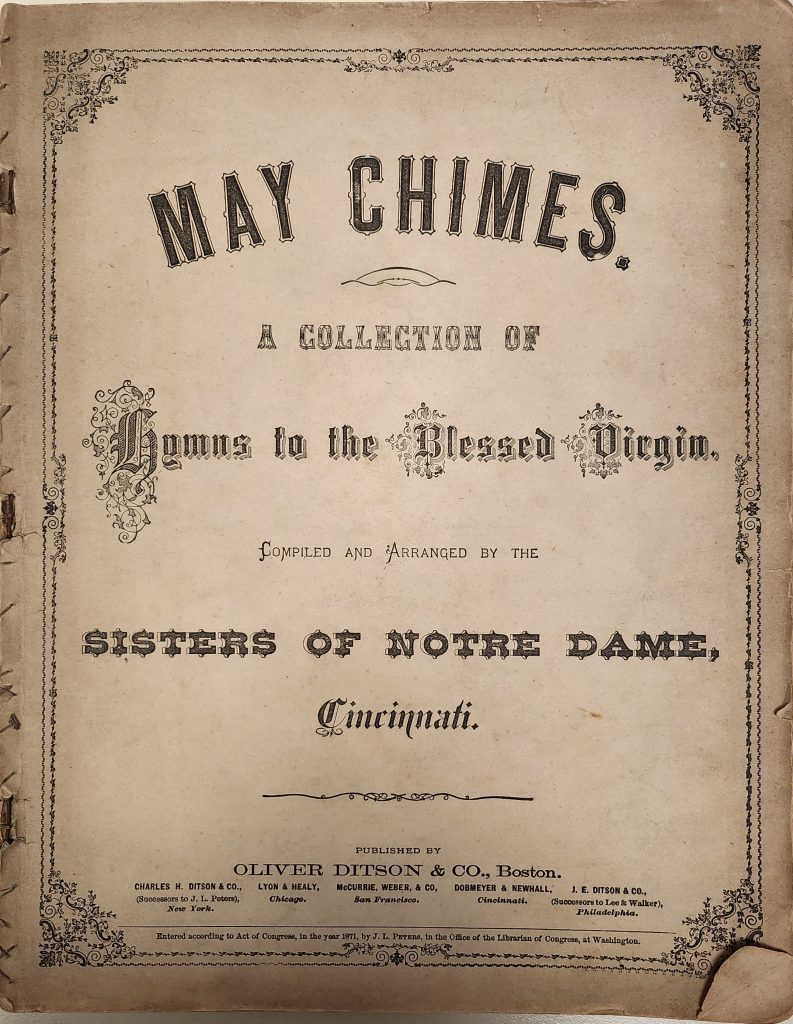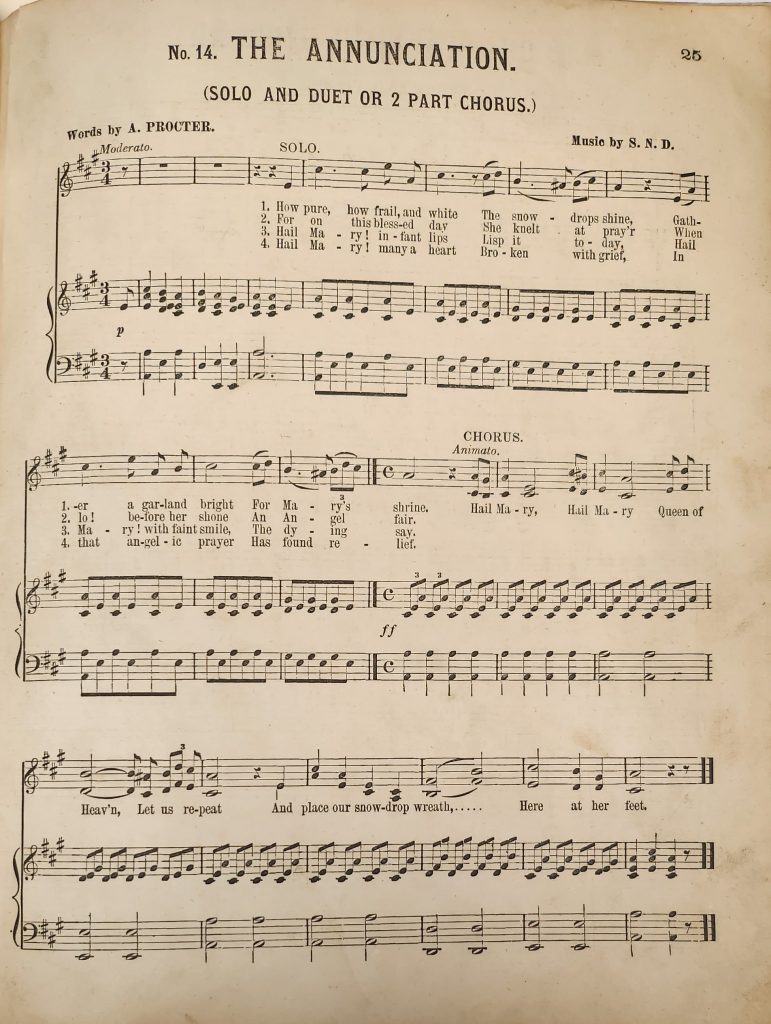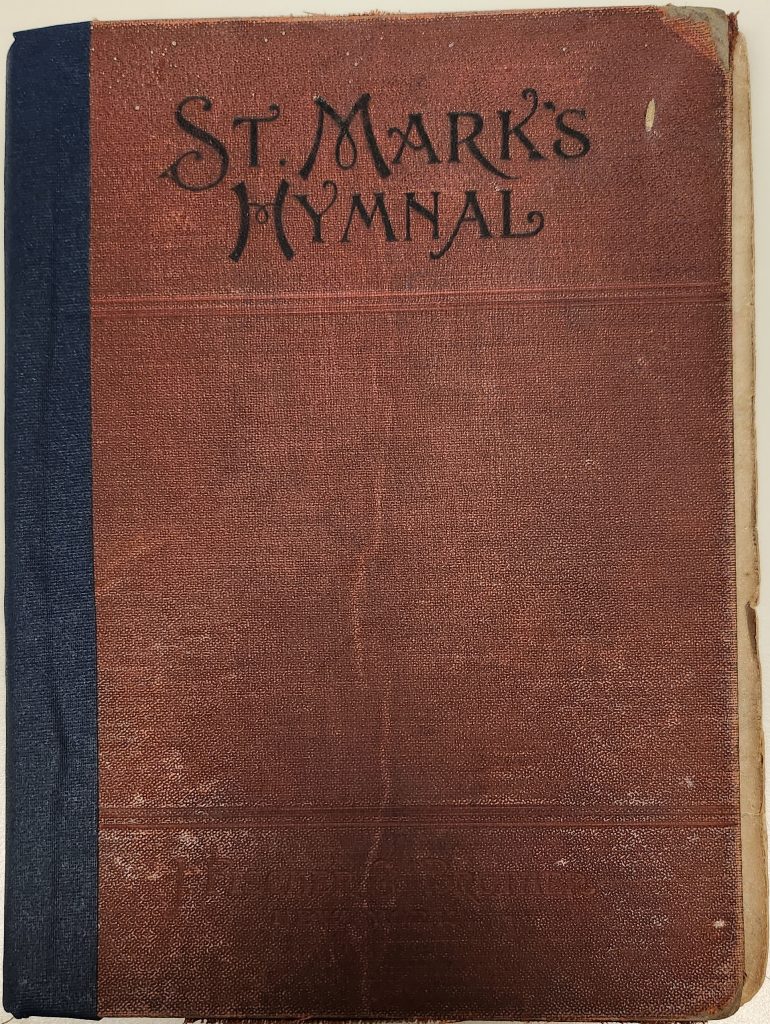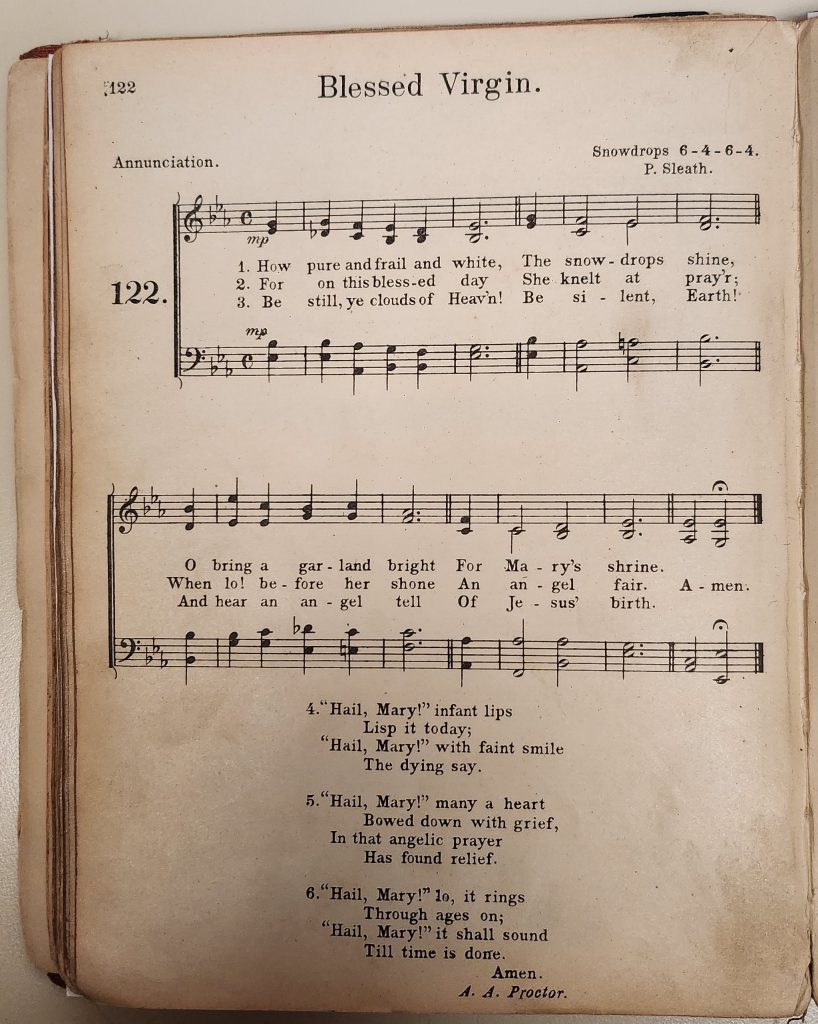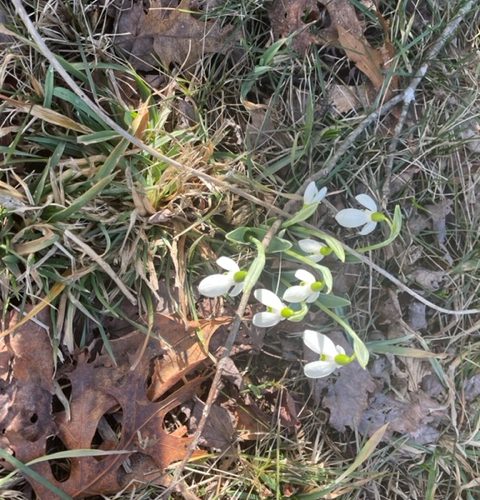This beautiful Eastertide anthem of the Blessed Virgin Mary, which is sung from Easter Sunday until Trinity Sunday, is thought to have originated when, according to legend, St. Gregory the Great (d. 604 A.D.) heard the first three lines chanted by angels on a certain Easter morning in Rome while he walked barefoot in a great religious procession and that the saint thereupon added the fourth line: Ora pro nobis Deum. Alleluia.
The Regina Coeli ranks among the other great Marian antiphons Alma Redemptoris Mater, Ave Regina Caelorum, and the Salve Regina. A translation of the Latin text is given below.
Regina coeli laetare, Alleluia,
Quia quem meruisti portare. Alleluia,
Resurrexit, Sicut dixit, Alleluia,
Ora pro nobis Deum. Alleluia.
Queen of Heaven rejoice, Alleluia,
For He whom thou didst merit to bear. Alleluia,
Has risen, as He said, Alleluia,
Pray for us to God. Alleluia.
Of all the melodies composed for this anthem including the great Gregorian melody there is one that stands out from all the rest that was used by St. Mary’s Choir in Akron, Ohio. It was a melody composed by Anthony Werner (1816-1866).
Anthony Werner was the Organist and Director of the Choir of the Cathedral of The Holy Cross, Boston, in the 1850s and 1860s. He was born in Bavaria, Germany, on October 9, 1816, to parents Domonic and Eve. He married Catherine Habnich (Hobnich) around 1847. She was born in Prussia, Germany, in 1823. He became a naturalized citizen of the United States on October 16, 1848. Anthony and Catherine had four children.
- Julius D. Werner (ca.1847 – 1903) died from heart disease, occupation a trader
- Cecilia M. H. Werner (ca. 1852 -1873) died from pulmonary tuberculosis (phthisis)
- Louis A. Werner (1853-1905) died from cancer, occupation a musician
- Catherine Louisa Werner (1861-1861) she was only twenty-four days old.
Anthony Werner died December 21, 1866, in Boston at the age of 50. He was still married to Catherine when he died.
The first appearance of his melody for Regina Coeli is found in THE MEMORARE, so named in honor of the Memorare prayer of St. Bernard. It is a collection of Catholic Music for Morning and Evening Services and for Daily or Private Devotions. It was compiled by Anthony Werner and published by the Oliver Ditson Company of Boston in 1857. The MEMORARE contains eight other compositions by Anthony Werner including an Asperges Me, Ave Maria, Ave Regina, a Mass in C, an O Salutaris, O Salutaris / Haec Dies, and two settings for Veni Creator. The MEMORARE saw later printings in 1885 and 1896 with contributions by Albert H. RoSewig, Director of the Choir of St. Charles Borromeo Church in Philadelphia.
The MEMORARE is unique in that it contains no Gregorian music and special care was taken by Anthony Werner to make sure that the music could be sung by the average church choir. Here is an excerpt from the Preface found in the MEMORARE that explains his reasoning behind the exclusion of Gregorian music.
Werner’s Regina Coeli was also published as a separate choral piece in 1885 by Oliver Ditson Co., with copyrights held by Mrs. A. Werner.
Later it was published by McLaughlin and Reilly Co., of Boston in 1922 were it was revised by James A. Reilly and again in 1952 were it was arranged for two voices by Edward Grey, a pseudonym for Father Joseph Portelance (1900-1979).
It was approved by the Society of St. Gregory and appeared in their White List of 1932. It was also used in Easter music programs of the 1930s.
Other publications by Anthony Werner include THE CANTATE. This was sold in two volumes beginning in 1862 and 1863. Also, Werner’s EIGHT EASY PIECES of Sacred Music for four voices – Soprano, Alto, Tenor, and Bass with Accompaniment for the Organ.
Anthony Werner’s most significant contribution to Catholic hymnody is his Benediction hymn O Salutaris Hostia / O Saving Victim which has become traditional and is found in most Catholic hymn books and some of today’s missalettes. By the 1970s, the English translation by Father Edward Caswall (1814-1878) was added.
Reflection
The Regina Coeli by Anthony Werner was regular Easter favorite of St. Mary’s Choir from 1977 through 2005 under the direction of organists Ralph Jordan and later Mary Leary. The choir sang the 1885 edition mentioned above. However, it wasn’t the only Regina Coeli the choir sang. I remember singing the following choral arrangements:
- Regina Coeli by Louis De Merlier and arr. by J. Wiegand, pub. by J. Fischer & Bro., 1914
- Regina Coeli by M. A. Melvil and arr. by Eduardo Marzo, pub. by Oliver Ditson Co., 1916
- Regina Coeli by Paolo Giorza by E. H. Benedict, 1896 (this is a Facebook link)
- Regina Coeli by M. Labat in The Catholic Youths Hymn Book by the Christian Brothers, 1871
I have often referred to St. Mary’s Choir in my hymn write ups and so I thought I might share a short anecdote on the organist Ralph J. Jordan (1916-1996). Mr. Jordan began playing the Austin organ at St. Mary’s on Christmas Eve for the Children’s Mass in 1929, he was only thirteen years old at the time. Of course, I didn’t meet Mr. Jordan (Ralph) until many years later in my Sophomore year of high school in 1977.
You see, the Howe family sat a few pews behind the organ near the front of the church on Mary’s side. I had good tenor voice and was not shy about singing. Anyway, Mr. Jordan was looking for new members for his choir and asked if I would like to join. I said, I would have to check with my Mom and Dad and see if they would approve. My brothers and sister didn’t do anything without Mom and Dad’s approval. Well they approved and I joined the choir in the fall of 1977. Practice was on Wednesday nights at 6:30 in the evening.
Mr. Jordan sang Bass, and he was a great musician and really knew how to make the Austin organ sing. I sang many solos under his direction including The Christ Child, one of my favorite Christmas anthems.
Below is a newspaper article from 1996 that appeared in the Akron Beacon Journal. It is wonderful tribute to a great man and a good friend.
I would like to thank Peter Meggison producer of The Devotional Hymns Project for allowing me to link to two new recordings of the Regina Coeli. The first is a recording of Anthony Werner’s Regina Coeli sung by a quartet of vocalists from Blessed Sacrament Church in Providence, Rhode Island. The second recording of the Regina Coeli was composed by M. A. Melvil and arranged by Eduardo Marzo. It was sung by the Advent Choir from The Church of the Advent, located in Boston’s Beacon Hill section. Take a few minutes to listen to these beautiful recordings by clicking on the links above.

